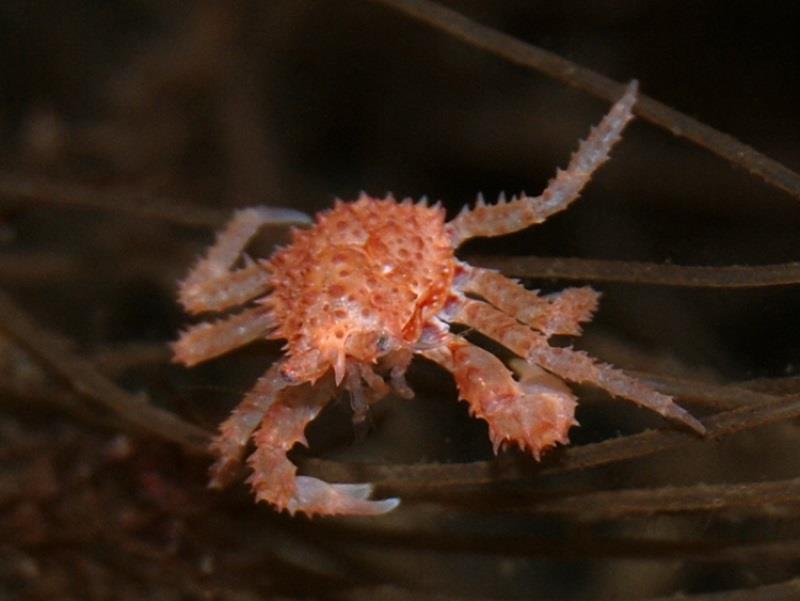
Enhancing Wild Red King Crab populations through Hatchery-Rearing Programs
by NOAA Fisheries 18 Mar 17:04 UTC

Underwater photograph of a juvenile red king crab © NOAA Fisheries/Chris Long
Scientists examine effects of release timing and size at release on survival of hatchery-reared red king crab.
A new study found that releasing red king crab as early as possible after they are reared in a hatchery may improve young crab survival and save operational costs. Scientists from the Alaska Fisheries Science Center observed that the best time to release hatchery-reared red king crab is right after they transition from free-swimming planktonic larvae to bottom dwelling juveniles.
Red king crab is an important commercial and subsistence fishery species in Alaska. It was commercially important around Kodiak, Alaska in the 1960s and 1970s, but the Kodiak stock crashed in the late 1970s. The causes of the population crash are still not fully understood. It was likely due to a combination of climatic shifts, changes in the food web structure, recruitment failure, and overfishing.
Although the commercial fishery has been closed since 1983, the Kodiak stock has not recovered. The lack of recovery has inspired consideration of stock enhancement through the release of hatchery-reared juveniles as a means to bolster the wild population.
Red King Crab Stock Enhancement and Release Strategies
NOAA Fisheries, commercial hatcheries and fishing groups, university groups, and State and Tribal governments formed the Alaska King Crabs Research, Rehabilitation, and Biology program. The group is examining the feasibility of a red king crab hatchery program.
Substantial preliminary work has already laid the foundation for experimental releases of red king crab raised in captivity. This includes:
- Optimizing hatchery techniques for rearing red king crab
- Field and laboratory experiments on red king crab behavior
- Feeding, predation, and field surveys to determine optimal habitat for a release area
"The next step to effective stock enhancement is developing strategies that maximize post-release survival," said Chris Long, lead author and research fishery biologist at the
Kodiak Laboratory.
During a previous set of experiments, Long and his colleagues looked at how the number or density of hatchery-reared red king crabs released in an area affected their survival.
"Then we had to figure out if timing and size at release would make a difference," added Long.
Post-Release Survival of Hatchery-Reared Red King Crab
During this small-scale experimental study, cohorts of hatchery-reared red king crab juveniles were released approximately every 6 weeks throughout the summer, starting in June. Scientists subsequently monitored densities of crabs inside and outside of release plots for 6 months. They recorded how many crabs died or moved out of the area.
They also recorded how many and what types of predators were in the area.
Mortality of hatchery-reared red king crab juveniles was greatest during early summer when crabs were at their smallest and most vulnerable to predation. Mortality generally decreased in later months. Later release dates corresponded with a larger size of crab at the time of release, which likely decreased the number of crabs eaten by predators. Scientists also found that crab migration rates increased at later release dates. This was likely due to increased size of crabs at the time of release as larger crabs tend to be more active.
However, the extended hatchery rearing period needed for later releases of larger crabs presents other challenges, including high rates of cannibalism in extended hatchery communal holding conditions.
"Rearing individual crabs in isolation improves survival, but is labor intensive on a large scale, affects growth, and could impede brain development. Stock enhancement programs must balance these trade-offs to maximize overall success," said Long.
Future Work to Improve Post-Release Survival
Based on the findings from their study, researchers recommend that future work should focus on methods to increase post-release survival, particularly during the first 24 hours and during the first 2 to 3 weeks. Scientists also recommended releasing the juveniles under screens or inside cages. This provides temporary protection while the young crabs adapt to their environment.
To reduce predation, the authors suggested that crabs could be released at night when predation is lower.
"It also would be worthwhile to experiment with some techniques to condition hatchery-reared crabs to predators," said Long.
For example, there is evidence that exposure to predators prior to release can induce hiding behavior that makes red king crab more difficult for predators to detect. This might decrease predation rates soon after release.